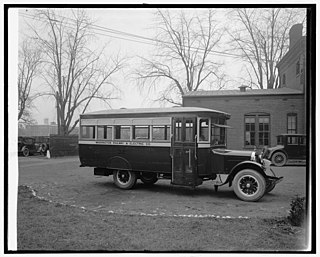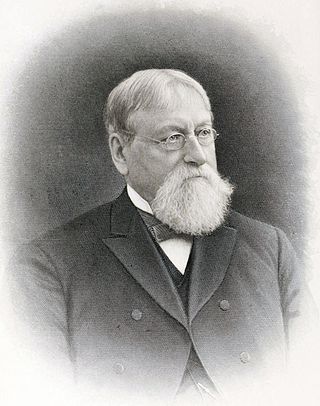
A tram is a rail vehicle that travels on tramway tracks on public urban streets; some include segments on segregated right-of-way. The tramlines or networks operated as public transport are called tramways or simply trams/streetcars. Many recently built tramways use the contemporary term light rail.

A trolleybus is an electric bus that draws power from dual overhead wires using spring-loaded trolley poles. Two wires, and two trolley poles, are required to complete the electrical circuit. This differs from a tram or streetcar, which normally uses the track as the return path, needing only one wire and one pole. They are also distinct from other kinds of electric buses, which usually rely on batteries. Power is most commonly supplied as 600-volt direct current, but there are exceptions.

A trolley pole is a tapered cylindrical pole of wood or metal, used to transfer electricity from a "live" (electrified) overhead wire to the control and the electric traction motors of a tram or trolley bus. It is a type of current collector. The use of overhead wire in a system of current collection is reputed to be the 1880 invention of Frank J. Sprague, but the first working trolley pole was developed and demonstrated by Charles Van Depoele, in autumn 1885.

Conduit current collection is an obsolete system of electric current collection used by some electric tramways, where the power supply was carried in a 'conduit' under the roadway. Modern systems fall under the term ground-level power supply.

The Toronto streetcar system is a network of nine streetcar routes in Toronto, Ontario, Canada, operated by the Toronto Transit Commission (TTC). It is the busiest light-rail system in North America. The network is concentrated primarily in Downtown Toronto and in proximity to the city's waterfront. Much of the streetcar route network dates from the 19th century. Most of Toronto's streetcar routes operate on street trackage shared with vehicular traffic, and streetcars stop on demand at frequent stops like buses. Since 2019, the network has used low-floor streetcars, making it fully accessible.

Streetcars in Washington, D.C. transported people across the city and region from 1862 until 1962.

The Rock Creek Railway was one of the first electric streetcar companies in Washington, D.C., and the first to extend into Maryland.

The National Capital Trolley Museum (NCTM) is a 501(c)(3) nonprofit organization that operates historic street cars, trolleys and trams for the public on a regular schedule. Located in Montgomery County, Maryland, the museum's primary mission is to preserve and interpret the history of the electric street and interurban railways of the National Capital region.

The Phoenix Street Railway provided streetcar service in Phoenix, Arizona, United States, from 1888 to 1948. The motto was "Ride a Mile and Smile the While."

The Galveston Island Trolley is a heritage streetcar network in Galveston, Texas, United States. As of late 2006, the total network length was 6.8 miles (10.9 km) with 22 stations. The Galveston Island Trolley is operated by Island Transit. The rail system reopened in 2021, after having been out of service for 13 years following severe damage caused by Hurricane Ike in 2008. Subsequent to the 2008 closure, the Federal Emergency Management Agency (FEMA) and the Federal Transit Administration agreed to fund repairs. In January 2017, a contract was approved to restore three of the trolleys at a cost of $3.8 million. At that time, the trolleys were expected to be ready to return to service in 2018, but the date was later postponed to 2019 and later to 2021. By November 2020, two reconditioned trolleys had returned to Galveston. The line reopened for service in October 2021, limited to three days a week for now.

The Washington Railway and Electric Company (WRECo) was the larger of the two major streetcar companies in Washington, D.C., and its Maryland suburbs in the early decades of the 20th century.
The history of trams, streetcars, or trolleys began in the early nineteenth century. It can be divided up into several discrete periods defined by the principal means of motive power used.

The Columbia Railway was the third streetcar company to operate in Washington, D.C. It was incorporated and started operations in 1870, running from the Treasury Building along H Street NW/NE to the city boundary at 15th Street NE. It switched to cable power in 1895 and then electric power in 1899. The company extended to Seat Pleasant, Maryland, and Kenilworth in 1898. In the late 19th century, it was purchased by the Washington Traction and Electric Company and on February 4, 1902, became a part of the Washington Railway and Electric Company.

Frank Brett Noyes was president of the Washington Evening Star, a daily afternoon newspaper published in Washington, D.C., and a founder of the Associated Press. He was a son of the Star's publisher Crosby Stuart Noyes.

Crosby Stuart Noyes was the publisher of the Washington Evening Star.
Crosby S. Noyes was an American newspaperman. He was a great-grandson of Crosby Stuart Noyes, a co-owner of the Washington Evening Star from 1867 to 1908 who was its long-time editor-in-chief. The younger Crosby Noyes was a son of Newbold Noyes, Sr., a Star associate editor. His older brother, Newbold Noyes, Jr., was the Star's editor from 1963 to 1975, when the paper was sold to Joe L. Allbritton, a banker. In 1978 Allbritton in turn sold the paper to Time, Inc., which closed it in 1981.

The H Street/Benning Road Line is a currently operating line of DC Streetcar. It has eight stations and began operation on February 27, 2016. The 2.4-mile (3.9 km) line runs along H Street NE and Benning Road NE in Washington, D.C. In September 2016 service was increased from six days a week to seven, and with shorter 12-minute headways.
Ellison Griffith Smith was a justice of the South Dakota Supreme Court from 1909 to 1923.
A trio of streetcar companies provided service along a single 10-mile line from the Washington, D.C., neighborhood of Georgetown northward and ultimately to Rockville, Maryland, in the early decades of the 20th century.















